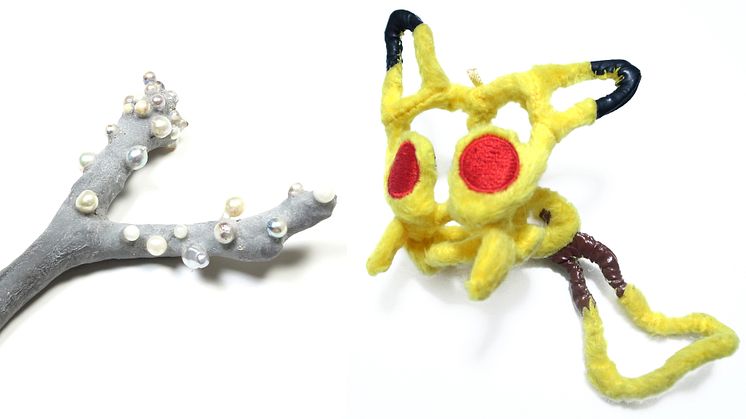
Press release -
Contemporary jewellery at Nationalmuseum Design this spring
This spring Nationalmuseum Design will host an exhibition of contemporary art jewellery. The exhibition features 30 artists from all over the world, with about 160 works on display. The curator is Dr. Ellen Maurer Zilioli, who is based in Germany.
The exhibition Open Space – Mind Maps. Positions in Contemporary Jewellery intends to illustrate the point at which the actual art in jewellery arrived and what cultural messages take on the most crucial importance in this context. The jewellery in the exhibitionrepresents adventure and experimentation aimed at opposing and protesting against traditional customs, propagandising a type of beauty that unifies provocation and aesthetics at the same time. Jewellery long ago breached frontiers, and acts as artistic field research, participating in the current topics of art in our time.
In our context, jewellery no longer represents a simple decoration or a status symbol, but an aesthetic discourse and artistic position that reacts to everyday life events, to personal history and experience, to worldwide developments and new forms of communications and perception. It handles the contents as contributions to the art, within and beyond the same classical frames. We are moving in an open space and every object, every piece contains the mind map of the singular artist and his or her cultural background.
In the exhibition 30 artists from the international scene will present the public with jewels and conceptual works, complemented with examples from the young collection of Nationalmuseum. In total there will be about 160 works on display. The selection of artists also covers the foremost academies and universities in the field of jewellery. Sophie Hanagarth teaches in Strasbourg, Karen Pontoppidan at the Academy of Fine Arts in Munich, Miro Sazdic at Ädellab at Konstfack in Stockholm, Suska Mackert at the Academy of Fine Arts in Nuremberg and Mikiko Minewaki at the Hiko Mizuno College in Tokyo and so on. Their work demonstrates the stronger impact of female artists, who provide a paradigm shift in handwriting, style, thematic issues and the appearance of jewellery today. This is also one of the reasons why the exhibition focuses in particular on the aspect of gender positions and gender shifts.
Participating artists:
Tobias Alm (*1985), Sweden
David Bielander (*1968), Switzerland
Maisie Broadhead (*1980), Great Britain
Beatrice Brovia (*1985), Italy
Sungho Cho (*1975), Korea
Eun Mi Chun (*1971), Korea
Iris Eichenberg (*1965), Germany/USA
Cristina Filipe (*1965), Portugal
Benedikt Fischer (*1984), Austria
Kiko Gianocca (*1974), Switzerland
Carolina Gimeno (*1981), Chile/Sweden
Sophie Hanagarth (*1968), Switzerland/France
Mielle Harvey (*1971), USA
Hanna Hedman (*1980), Sweden
Jutta Kallfelz (*1975), Germany
Auli Laitinen (*1967), Sweden
Suska Mackert (*1969), Germany
Sally Marsland (*1969), Australia
Märta Mattsson (*1982), Sweden
Nanna Melland (*1969), Norway
Mikiko Minewaki (*1967), Japan
Karen Pontoppidan (*1968), Denmark/Germany
Janja Prokic (*1984), Serbia/Czech Republic
Miro Sazdic (*1966), Sweden
Aud Charlotte Ho Sook Sinding (1972-2009), Norway/Sweden
Mirei Takeuchi (*1969), Germany/Japan
Ketli Tiitsar (*1972), Estonia
Tarja Tuupanen (*1973), Finland
Norman Weber (*1964), Germany
Annamaria Zanella (*1966), Italy
The curator is Dr. Ellen Maurer Zilioli from Germany, educated at Munich and Basel Universities, former academic employee at the Bayerische Staatsgemäldesammlungen and Neue Sammlung, State Museum of Applied Arts and Design in Munich and curator at the Neue Sammlung, Design in der Pinakothek der Moderne in Munich. www.maurer-zilioli.com
The exhibition will be accompanied by a publication of about 230 pages. All the artists will have a statement on their work within the book. The catalogue will be published by Arnoldsche Art Publishers, Stuttgart. www.arnoldsche.com
The exhibition Open Space – Mind Maps. Positions in Contemporary Jewellery will be on show at Nationalmuseum Design at Kulturhuset Stadsteatern in Stockholm from 11 March to 15 May 2016.
Press contact
Hanna Tottmar, Press Officer, hanna.tottmar@nationalmuseum.se, +46 767 234632
Caption
Märta Mattsson, brooch, 2014; Mikiko Minewaki, soft toy pika-chu, brooch, 2015.
Nationalmuseum is Sweden’s premier museum of art and design. The collections comprise older paintings, sculpture, drawings and graphic art, and applied art and design up to the present day. The museum building is currently under renovation and scheduled to open again in 2018. In the meantime, the museum will continue its activities through collaborations both in Sweden and abroad as well as temporary exhibitions at the Royal Swedish Academy of Fine Arts, Fredsgatan 12 and Nationalmuseum Design at Kulturhuset Stadsteatern in Stockholm. Nationalmuseum has partnerships with Svenska Dagbladet and the Grand Hôtel Stockholm, and acknowledges the support of FCB Fältman & Malmén.

